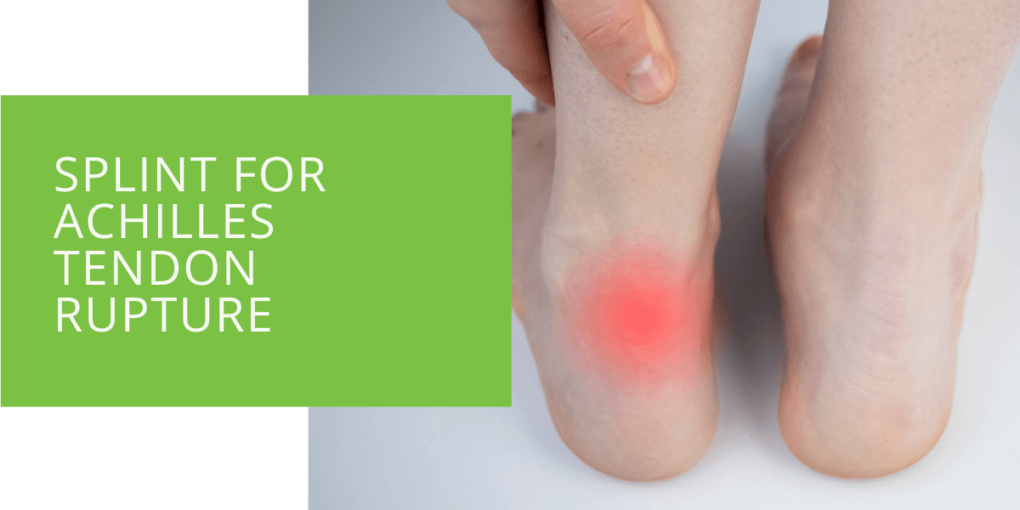Splint for Achilles Tendon Rupture
Achilles tendon rupture is a debilitating injury that can greatly impact mobility and quality of life. Whether caused by sudden trauma or degenerative changes over time, this condition requires prompt and effective treatment to facilitate healing and prevent further complications. This comprehensive guide will explore splints' role in managing Achilles tendon rupture, including their intended use, benefits, and tips for effective usage.
Key Takeaways
- Prompt treatment is crucial for Achilles tendon rupture, with options ranging from non-surgical methods like rest, ice, and physical therapy to surgical interventions.
- Achilles tendon splints provide support, stability, and pain relief, promoting proper alignment and facilitating healing.
- Choosing the right splint, following proper usage instructions, and considering night splinting can optimize the benefits of using an Achilles tendon splint during recovery.
Understanding Achilles Tendon Rupture
The Achilles tendon is the largest in the body, connecting the calf muscles to the heel bone. A rupture occurs when this tendon tears partially or completely, often resulting in sudden and severe pain. Various factors, including sudden movements, overuse, or degenerative changes in the tendon tissue, can cause this injury.
What Causes Achilles Tendon Rupture?
Signs and Symptoms of Achilles Tendon Rupture
Achilles tendon rupture typically presents with symptoms such as sharp pain and swelling in the back of the ankle, difficulty walking or bearing weight on the affected leg, and a noticeable gap or indentation in the tendon.
Treatment Options for Achilles Tendon Rupture
Prompt treatment is essential for Achilles tendon rupture to prevent further damage and facilitate optimal healing. While some cases may require surgical intervention, many can be managed conservatively with non-surgical methods.
Non-Surgical Treatment Options
Non-surgical treatment options for Achilles tendon rupture may include:
- Rest, Ice, Compression, Elevation (RICE): Initial management often involves rest, ice packs, compression bandages, and elevation of the affected leg to reduce pain and inflammation.
- Physical Therapy: Physical therapy exercises and stretches can help strengthen the surrounding muscles, improve range of motion, and promote healing of the tendon.
- Use of Orthotic Devices: Orthopedic inserts, braces, or splints may be recommended to provide support and stability to the ankle and foot during the healing process.
Surgical Treatment Options
In cases where conservative measures fail to provide adequate relief or the tendon tear is severe, surgical intervention may be necessary. Achilles tendon repair surgery aims to reattach the torn tendon and restore its function, followed by post-operative rehabilitation to regain strength and mobility.
Introducing the Achilles Tendon Splint
An Achilles tendon splint is a specialized orthopaedic device designed to immobilize and support the ankle and foot during the healing process following a tendon rupture. These splints are typically worn during periods of rest or sleep to prevent excessive ankle joint movement and promote proper alignment of the tendon for optimal healing.
What is an Achilles Tendon Splint?
Intended Use of the Splint
The primary purpose of an Achilles tendon splint is to provide stability and support to the ankle and foot while minimizing strain on the injured tendon. By immobilizing the ankle joint in a neutral position, the splint helps reduce pain, inflammation, and the risk of further injury during the critical early stages of healing.
How Does the Splint Work?
Types of Achilles Tendon Splints
Achilles tendon splints come in various designs and materials, ranging from soft, flexible braces to rigid, custom-made orthoses. The choice of splint depends on factors such as the severity of the injury, individual preferences, and the recommendations of a healthcare professional.

Choosing the Right Splint
The appropriate Achilles tendon splint ensures optimal comfort, support, and effectiveness during healing. Several factors should be considered when choosing a splint, including size and fit, comfort and material, adjustability, and intended use.
Factors to Consider
- Size and Fit: The splint should fit snugly around the ankle and foot without being too tight or restrictive. It should also provide adequate support to prevent excessive movement of the ankle joint.
- Comfort and Material: Choose a splint made from breathable, lightweight materials that are comfortable to wear for extended periods, especially during sleep.
- Adjustability: Look for splints with adjustable straps or closures to customize fit and compression.
- Consulting a Podiatrist: For personalized recommendations and assistance in choosing the right splint for Achilles tendon rupture, consult a podiatrist or orthopedic specialist.
Benefits of Using a Splint for Achilles Tendon Rupture
The use of a splint for Achilles tendon rupture offers several benefits, including:
Pain Relief and Comfort
Achilles tendon splints help alleviate pain and discomfort by immobilizing the ankle joint and reducing strain on the injured tendon during movement.
Support and Stability
Splints provide stability to the ankle and foot, preventing excessive motion and promoting proper alignment of the tendon for optimal healing.
Prevention of Further Injury
By restricting ankle joint movement, splints help minimize the risk of further damage to the already compromised tendon, allowing for uninterrupted healing.
Facilitation of Healing Process
By maintaining the ankle in a neutral position, splints promote the natural healing process of the tendon, leading to faster recovery and improved outcomes.
Tips for Using an Achilles Tendon Splint Effectively
To maximize the benefits of using an Achilles tendon splint, follow these tips for practical usage:
Proper Usage Instructions
Follow the manufacturer's instructions for wearing the splint, including properly positioning and securing it around the ankle and foot.
Night Splinting for Achilles Tendon Rupture
Consider wearing the splint at night while sleeping to provide continuous support and immobilization of the ankle joint during the critical healing period.
Maintenance and Care of the Splint
Regularly clean and inspect the splint for signs of wear or damage, and replace it as needed to ensure optimal support and effectiveness.
Conclusion
Achilles tendon rupture can significantly impact mobility and quality of life, but prompt and effective treatment can facilitate healing and restore function to the affected limb. By understanding the role of splints in managing Achilles tendon rupture and following the tips for effective usage, individuals can optimize their recovery and minimize the risk of complications. At ePodiatrists, we provide comprehensive care and personalized treatment options for foot and ankle conditions. If you're experiencing symptoms of Achilles tendon rupture or have questions about splinting options, schedule an appointment with our experienced podiatrists today.
Don't let Achilles tendon issues hold you back—take the first step towards recovery and schedule your appointment now.

